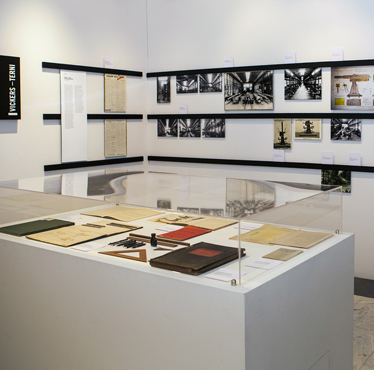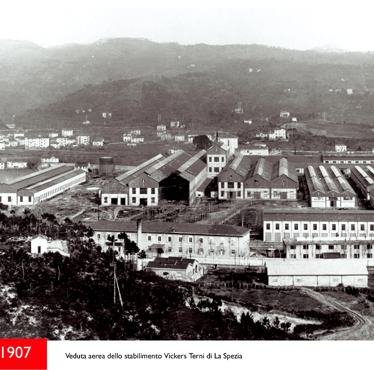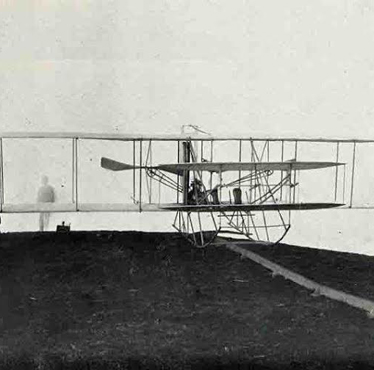Roma 30 November 2014
The history of 1900s Italian industry is made of talent and invention of brave, innovative men. We find some of these characters in the history of the Finmeccanica companies; characters such as Attilio Odero and Giuseppe Orlando, who from 1905 to 1908 took part in the constitution of Vickers Terni, the company that laid the basis for what is today OTO Melara, operating in the land and naval artillery systems.
“Uomini d’acciaio 1900-1920. La Spezia tra sogno e divenire” (Steel Men 1900-1920 La Spezia dreaming and becoming) tells us the story of these men: a photographic and multimedia exhibition created from a project of the municipality of La Spezia, the Italian Navy, the Fincantieri Foundation and the Melara Museum Association (through OTO Melara) under the scope of the protection and optimisation of the various archived heritage of the territory.
 The exhibition, which is hosted by the La Spezia Palazzina delle Arti, will be open to the public from 28 November to 29 March 2015. Structured into three themed areas - City, Industry and Military deeds - the exhibition presents findings and archived materials of various different types: photographic, technical and epistolary, conserved both at the historic company archives, with a view to extending the use of the document heritage, making it more easily available within a single citizen and territorial circuit. The material was studied and selected with the idea of telling about the men who have most stood out for their ingenious discoveries, capacity, heroic actions and contributions made to the growth and development of La Spezia, in the period running from the early 1900s through to the First World War.
The exhibition, which is hosted by the La Spezia Palazzina delle Arti, will be open to the public from 28 November to 29 March 2015. Structured into three themed areas - City, Industry and Military deeds - the exhibition presents findings and archived materials of various different types: photographic, technical and epistolary, conserved both at the historic company archives, with a view to extending the use of the document heritage, making it more easily available within a single citizen and territorial circuit. The material was studied and selected with the idea of telling about the men who have most stood out for their ingenious discoveries, capacity, heroic actions and contributions made to the growth and development of La Spezia, in the period running from the early 1900s through to the First World War.
These naturally include Attilio Odero (1854-1945), entrepreneur in the naval, automotive and steel sector and Giuseppe Orlando (1855-1926), engineer and industrial player operating in shipbuilding, steel, metallurgy and artillery segments. Both were committed to Vickers-Terni, the  joint venture established by Acciaierie Terni and the British Vickers to create a plant devoted to the naval artilleries in the district of Melara, La Spezia. In 1929, the two entrepreneurs took over the company, now left with Acciaierie Terni, following the exit by the British shareholder, and created Oderno-Terni-Orlando (hence the acronym in the trademark of today's OTO Melara), joining it with the Odero shipyard of Genoa and that of Orlando in Livorno. In 1993, following a period of crisis, the company was taken over by IRI - Istituto per la Ricostruzione Industriale (Institute for Industrial Reconstruction). The names of Odero and Orlando are connected with other historic companies that have flowed into the Finmeccanica Group: the Odero shipyards took over ownership of Ansaldo - San Giorgio of Genoa, whilst Orlando took on the office of chairman of numerous industrial companies, including Officine Galileo, in whose creation he was actively involved, Ernesto Breda and the torpedo factory Whitehead of Fiume, which he had taken over and, in the following years, gave rise to today's WASS.
joint venture established by Acciaierie Terni and the British Vickers to create a plant devoted to the naval artilleries in the district of Melara, La Spezia. In 1929, the two entrepreneurs took over the company, now left with Acciaierie Terni, following the exit by the British shareholder, and created Oderno-Terni-Orlando (hence the acronym in the trademark of today's OTO Melara), joining it with the Odero shipyard of Genoa and that of Orlando in Livorno. In 1993, following a period of crisis, the company was taken over by IRI - Istituto per la Ricostruzione Industriale (Institute for Industrial Reconstruction). The names of Odero and Orlando are connected with other historic companies that have flowed into the Finmeccanica Group: the Odero shipyards took over ownership of Ansaldo - San Giorgio of Genoa, whilst Orlando took on the office of chairman of numerous industrial companies, including Officine Galileo, in whose creation he was actively involved, Ernesto Breda and the torpedo factory Whitehead of Fiume, which he had taken over and, in the following years, gave rise to today's WASS.
The exhibition route proposes numerous lead figures on the local industrial and military scene, such as Alessandro Marchetti (1884-1966), engineer and aeronautical designer, who was technical manager for Vickers-Terni and designed the Marchetti MVT, a fighter aeroplane and winner from 1918 to 1919 of various speed awards. The passion for flight took Marchetti, a few years later, to take over SIAI (Società Idrovolanti Alta Italia)-Savoia, which later became SIAI-Marchetti, another historic company whose traces can be seen in Finmeccanica's family tree. We should just  mention another character recalled in the exhibition, namely Mario Calderara (1879-1944), an officer of the Regia Marina [Italian Royal Navy], inventor, experimenter and pioneer in flight, as well as the first Italian pilot to achieve a flight licence in 1909, taking lessons directly from Wilbur Wright and rubbing shoulders with the most important aviation pioneers of the times, such as Otto Lillienthal, Léon Delagrange and Gabriel Voisin. And more, Attilio Baratta, who designed the civic aqueduct built during the early years of the last century to satisfy the increased water needs of the population; Angelo Belloni, officer and then technical consultant of the Regia Marina, who, through his inventions (the Belloni tank for the exit from submarines and the Belloni hood, enabling man to move freely beneath the water's surface) helped towards the creation of modern diving and made the attacks possible during the second world war. Finally, Raffaele Rossetti (1881-1952), officer of the Regia Marina, engineer, designer, tester and operator of the self-propelled torpedoe Rossetti or "Mignatta", protagonist in 1918 of the historic, heroic undertaking of the sinking of the Austrian battleship "Viribus Unitis" in the port of Pola, in Istria.
mention another character recalled in the exhibition, namely Mario Calderara (1879-1944), an officer of the Regia Marina [Italian Royal Navy], inventor, experimenter and pioneer in flight, as well as the first Italian pilot to achieve a flight licence in 1909, taking lessons directly from Wilbur Wright and rubbing shoulders with the most important aviation pioneers of the times, such as Otto Lillienthal, Léon Delagrange and Gabriel Voisin. And more, Attilio Baratta, who designed the civic aqueduct built during the early years of the last century to satisfy the increased water needs of the population; Angelo Belloni, officer and then technical consultant of the Regia Marina, who, through his inventions (the Belloni tank for the exit from submarines and the Belloni hood, enabling man to move freely beneath the water's surface) helped towards the creation of modern diving and made the attacks possible during the second world war. Finally, Raffaele Rossetti (1881-1952), officer of the Regia Marina, engineer, designer, tester and operator of the self-propelled torpedoe Rossetti or "Mignatta", protagonist in 1918 of the historic, heroic undertaking of the sinking of the Austrian battleship "Viribus Unitis" in the port of Pola, in Istria.

